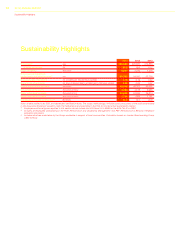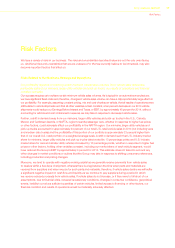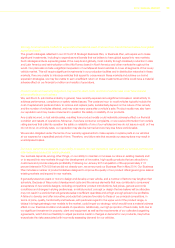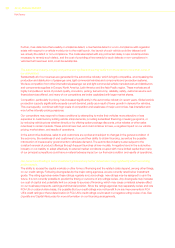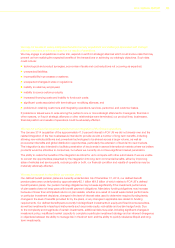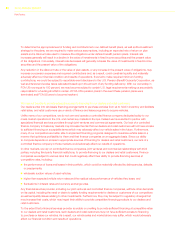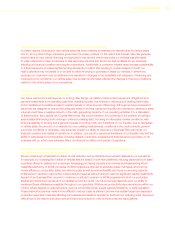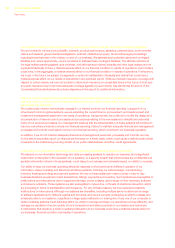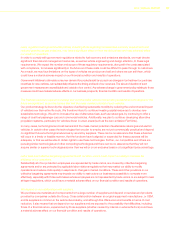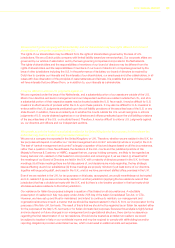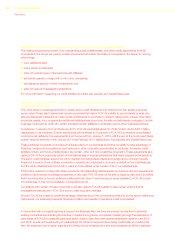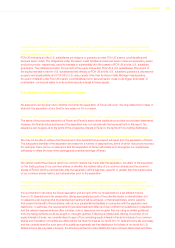Chrysler 2014 Annual Report Download - page 25
Download and view the complete annual report
Please find page 25 of the 2014 Chrysler annual report below. You can navigate through the pages in the report by either clicking on the pages listed below, or by using the keyword search tool below to find specific information within the annual report.
2014 | ANNUAL REPORT 23
Vehicle sales depend heavily on affordable interest rates for vehicle financing.
In certain regions, financing for new vehicle sales has been available at relatively low interest rates for several years
due to, among other things, expansive government monetary policies. To the extent that interest rates rise generally,
market rates for new vehicle financing are expected to rise as well, which may make our vehicles less affordable
to retail customers or steer consumers to less expensive vehicles that tend to be less profitable for us, adversely
affecting our financial condition and results of operations. Additionally, if consumer interest rates increase substantially
or if financial service providers tighten lending standards or restrict their lending to certain classes of credit, our
retail customers may not desire to or be able to obtain financing to purchase or lease our vehicles. Furthermore,
because our customers may be relatively more sensitive to changes in the availability and adequacy of financing and
macroeconomic conditions, our vehicle sales may be disproportionately affected by changes in financing conditions
relative to the vehicle sales of our competitors.
Limitations on our liquidity and access to funding may limit our ability to execute our Business Plan and improve our
financial condition and results of operations.
Our future performance will depend on, among other things, our ability to finance debt repayment obligations and
planned investments from operating cash flow, available liquidity, the renewal or refinancing of existing bank loans
and/or facilities and possible access to capital markets or other sources of financing. Although we have measures in
place that are designed to ensure that adequate levels of working capital and liquidity are maintained, declines in sales
volumes could have a negative impact on the cash-generating capacity of our operating activities. For a discussion
of these factors, see Liquidity and Capital Resources. We could, therefore, find ourselves in the position of having to
seek additional financing and/or having to refinance existing debt, including in unfavorable market conditions, with
limited availability of funding and a general increase in funding costs. Any limitations on our liquidity, due to decreases
in vehicle sales, the amount of or restrictions in our existing indebtedness, conditions in the credit markets, general
economic conditions or otherwise, may adversely impact our ability to execute our Business Plan and impair our
financial condition and results of operations. In addition, any actual or perceived limitations of our liquidity may limit the
ability or willingness of counterparties, including dealers, customers, suppliers and financial service providers, to do
business with us, which may adversely affect our financial condition and results of operations.
Our ability to achieve cost reductions and to realize production efficiencies is critical to maintaining our
competitiveness and long-term profitability.
We are continuing to implement a number of cost reduction and productivity improvement initiatives in our operations,
for example, by increasing the number of vehicles that are based on common platforms, reducing dependence on sales
incentives offered to dealers and consumers, leveraging purchasing capacity and volumes and implementing World
Class Manufacturing, or WCM, principles. WCM principles are intended to eliminate waste of all types, and improve
worker efficiency, productivity, safety and vehicle quality as well as worker flexibility and focus on removing capacity
bottlenecks to maximize output when market demand requires without having to resort to significant capital investments.
As part of our Business Plan, we plan to continue our efforts to extend our WCM programs into all of our production
facilities and benchmark across all of our facilities around the world. Our future success depends upon our ability to
implement these initiatives successfully throughout our operations. While some productivity improvements are within our
control, others depend on external factors, such as commodity prices, supply capacity limitations, or trade regulation.
These external factors may make it more difficult to reduce costs as planned, and we may sustain larger than expected
production expenses, materially affecting our business and results of operations. Furthermore, reducing costs may prove
difficult due to the need to introduce new and improved products in order to meet consumer expectations.



